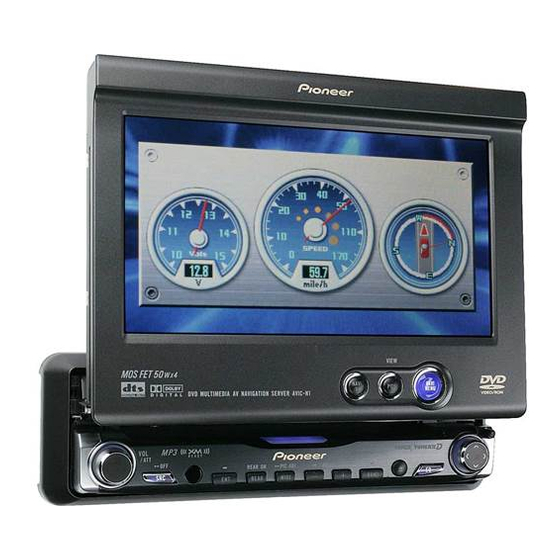Pioneer AVIC-N1 Hardware Manual - Page 22
Browse online or download pdf Hardware Manual for Car Receiver Pioneer AVIC-N1. Pioneer AVIC-N1 28 pages. Technical menu
Also for Pioneer AVIC-N1: Owner's Manual (34 pages), User Manual (24 pages), Manual (10 pages)

Error messages
➲ About error messages ➞ Appendix of the
Operation Manual
Vehicles that Cannot Obtain
Speed Pulse Data
The speed pulse data comes from the speed
sensing circuit. The location of this speed sens-
ing circuit depends on your vehicle model. In
some cases, it is impossible to make a connec-
tion to it, and in such a case we recommend that
the ND-PG1 speed pulse generator (sold sepa-
rately) be used.
• Be sure to connect the speed pulse lead. If
not, vehicle location error will increase.
Conditions Likely to Cause
Noticeable Positioning Errors
For various reasons such as the state of the road
you are traveling on and the state of reception of
the GPS signal, the actual position of your vehicle
may differ from the position displayed on the map
screen.
Some types of vehicle may not output a speed
signal while driving at just a few miles per hour.
In such a case, the current location of your vehi-
cle may not be displayed correctly while in a traf-
fic jam or in a car park.
• The current vehicle position cannot be dis-
played exactly under all conditions, due to vari-
ations in satellite reception, road conditions,
the vehicle's condition, and any objects in con-
tact with the antenna.
• Also, GPS reception may be unavailable during
certain weather conditions, when driving in
tunnels or garages, or when signal interfer-
ence may occur such as when driving between
tall buildings or near large vehicles.
Handling and Care of the Disc
Some basic precautions are necessary when
handling your discs.
20
Navigation map discs
• Do not use discs other than those intended for
this product. Use only discs approved by Pio-
neer.
➲ For suitable discs ➞ Page 7
❒ If you wish to use other navigation discs,
first check that they are compatible with
this equipment and approved by Pioneer.
DVD drive and care
• Use only normal, round discs. If you insert
irregular, non-round, shaped discs they may
jam in the DVD drive or not play properly.
• Check all discs for cracks, scratches or warp-
ing before playing. Discs that have cracks,
scratches or are warped may not play properly.
Do not use such discs.
• Avoid touching the recorded (non-printed side)
surface when handling the disc.
• Store discs in their cases when not in use.
• Keep discs out of direct sunlight and do not
expose the discs to high temperatures.
• Do not attach labels, write on or apply chemi-
cals to the surface of the discs.
• To clean dirt from a disc, wipe the disc with a
soft cloth outward from the center of the disc.
• If the heater is used in cold weather, conden-
sation may form on components inside the
DVD drive. Condensation may cause the DVD
drive to not operate properly. If you think that
condensation is a problem turn off the DVD
drive for an hour or so to allow the DVD drive to
dry out and wipe any damp discs with a soft
cloth to remove the moisture.
• Road shocks may interrupt disc playback.
DVD discs
• With some DVD video discs, it may not be pos-
sible to use certain functions.
